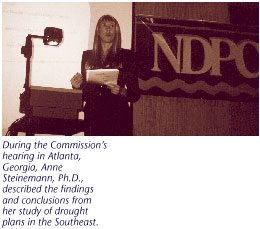|
|
| Return to Table of Contents |
|
The 1935 Soil Conservation Act authorized the U.S. Department of Agriculture to provide assistance for individual farmers and ranchers to develop and implement conservation plans. This legislation responded to the persistent drought of the 1930s and the resulting "Dust Bowl" caused by severe wind erosion. For 65 years, hundreds of thousands of farmers and ranchers have received technical and financial assistance to address critical resource needs. Under this voluntary program, assistance is provided at the request of the farmer and normally for specific needs such as erosion, water quality, or irrigation problems that the farmer identifies. Limited authorities and funds as well as lack of coordination among and within federal agencies hinder these planning efforts. For the Bureau of Reclamation’s Drought Program, requests for planning assistance far outweigh available funds, and the program provides technical assistance only, not direct grants. The Corps of Engineers water resource planning program is not specifically targeted to drought needs, and drought is not receiving much attention in these efforts. Witnesses told us that there is too much program bureaucracy within the Department of Agriculture. Tribal representatives expressed appreciation for the Department ‘s current effort to place offices on tribal lands, but stated they are far behind their non-tribal counterparts. We heard, too, that developing a drought plan or incorporating drought concerns into a more comprehensive water management plan is of little value unless the plan is implemented. Successful implementation of community drought plans requires practice, particularly when the people who are responsible for responding to drought may not be the same from drought to drought. Enough time passes between droughts that the issues change, water use changes, and professional staff members retire or move to new jobs. Many of the entities involved in drought response during the late 1990s, for example, were also involved in drought response during the late 1980s, but very few of the same people were still participating. As the Army Corps of Engineers, the Denver Water Authority, and the Interstate Compact on the Potomac River told us, communities need to prepare plans for drought and then exercise them, like fire drills, to keep the plan up to date and train new staff. Several of these points were reinforced at the Commission’s hearing in Atlanta, Georgia, by Dr. Anne Steinemann, an assistant professor at the Georgia Institute of Technology Graduate City Planning Program. From her study of more than 100 drought plans in the Southeast, she concluded in part that "even the most technically sophisticated and detailed plans with a lot of data may be ineffective if water officials and stakeholders can’t or won’t implement these measures…." Dr. Steinemann also told the Commission that drought planning often suffers from from lack of "agency staff experienced and expert in drought" and that "drought plans can't be developed without consulting the people who have institutional experience in managing drought." Return to Table of Contents | (Next Page)
|
|
|

